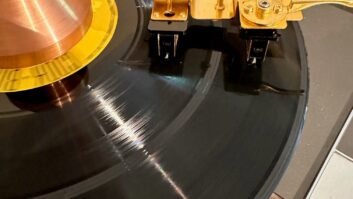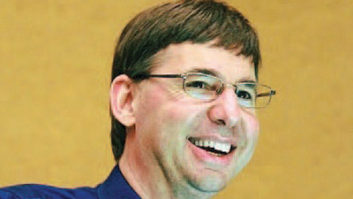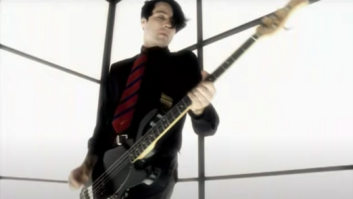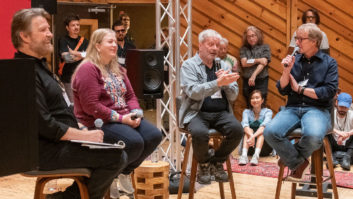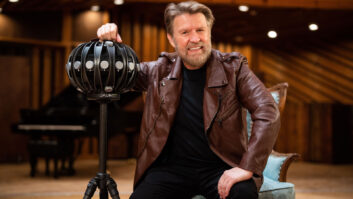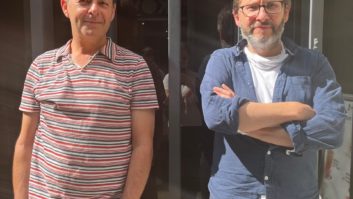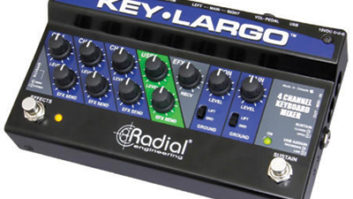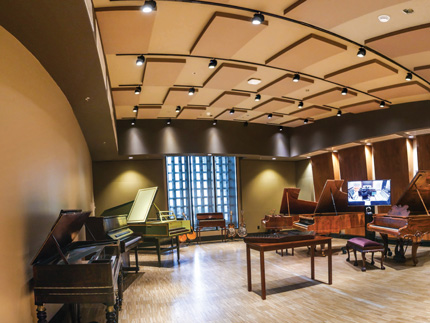
Studio Bell — National Music Centre, Calgary, Alberta
The National Music Centre, known as Studio Bell, comprises a large museum housing an extensive collection of musical instruments, a performance center, workshop, exhibits and recording facilities designed by Pilchner Schoustal International of Toronto. “The studio and museum were built at the same time from ground up, always with the intention of creating and celebrating music,” says PSI’s Martin Pilchner. “The studio’s stated mission is to be a national catalyst for discovery, innovation and renewal through music.”
Artists may apply to use the studio and instruments through NMC’s Artists in Residence program. If they are selected, they have access to keyboards, synths and other instruments from the museum’s collection, as well as all of the audio gear amassed by the NMC.

The studio design incorporates two control rooms: one housing the original Olympic Studios (London, UK) recording console, and the other fitted with an original Trident A Range. This facility also incorporates a large main tracking room, a black box event space known as King Eddy, plus the fully restored Rolling Stones Mobile studio, an Electronic Lab offering an extensive synth collection, and an Acoustic Lab with vintage pianos and keyboards. All of the spaces are tied together to be shared within the space.
“As the Rolling Stones Mobile is an artifact in itself, the key was to design the technical integration to the building infrastructure in a completely non-invasive manner,” says Pilchner. “We worked very closely with Jesse Moffat, John Leimseider and Jason Tawkin [from the NMC] to develop flexible recording spaces that were capable of working in a number of configurations, depending upon session requirements and collection items in use,” Pilchner continues.

“We developed the idea of creating, firstly, a permanent home for both the Trident and Olympic consoles, and secondly, a number of record spaces each with its own acoustic signature.”
Photo by RSPE Audio Solutions

Los OlivosRecording Studios, San Fernando Valley, Calif.
Beto Hale’s Los Olivos Recording Studios is a new ground-up, 2,000-square-foot studio designed by Kaufman & Associates of Los Angeles. The live room features a 20-foot ceiling and two adjacent iso rooms. The control room is equipped with a Pro Tools HDX system and Avid S6, as well as a 5.1 monitoring system using three PMC IB1S-AIII reference monitors across the front, a wide array of mic pre’s and vintage mics, guitars, amps and drums, and a Steinway Model A piano. Kaufman designed the entire facility to exceed NC15 noise specs, and he says that the live room, with a 725ms RT60, produces a warm yet detailed sound field.

Oktaven Audio, Mt. Vernon, N.Y.
Opened this past summer, Oktaven Audio’s new studios were designed by Francis Manzella of FM Design, New York City, to serve classical and jazz recording artists. A 1,200-square-foot live room offering two 9-foot Steinway D concert grands is augmented by a smaller acoustic isolation booth and a comfortable control room. The studios were built with a modest budget inside a converted warehouse/manufacturing building. Control Room A features a Studer 903 analog mixing console that was formerly used as the Metropolitan Opera’s main broadcast board.

Photo: Eric Meyer
416 Wabash, Indianapolis, Ind.
416 Wabash is a hybrid recording studio/event space in downtown Indianapolis. Designed by Gavin Haverstick of local firm Haverstick Designs, the studio control room features custom wood-slat wall treatments, and rear-wall diffusers provided by Overtone Acoustics. An iso booth is treated with various stone surfaces and absorption/bass trapping via stretch-fabric systems and clouds. The 7,500-square-foot event space accommodates live music and other events, but also ties into the studio to allow recording from the stage. Audio gear includes an SSL XL console, Focal Twin6 B3 monitors and Pro Tools HD2 Accel.

Photo: Gary Krueger
Levels Audio, Hollywood, Calif.
Two new rooms went online at this busy sound-for-picture complex this past December, bringing the total to nine suites, all designed by Peter Grueneisen’s nonzero\architecture – studio bau:ton. In both of the new rooms, vertical-grain Douglas fir paneling and acoustical diffusers complement fabric walls and a polished concrete floor. The new Mix Room 9, Brian Riordan’s flagship studio, includes a Dolby Atmos system; Alcons monitors are soffited in a speaker baffle situated behind the perforated screen. There is also an Avid S6 m40 console, Pro Tools HDX3 system, and BSS Blu806/180 room EQ control with Blu10 controller. Mix Room 8 offers a Pro Tools HDX2 system, ADAM 5.1 monitoring system, and an Avid D-Command console.

Photo: Shawn Frederick/GA-Prod.com
Afterhours Studio, Los Angeles
Grammy-winning producer/engineer Rafa Sardina has been working primarily in his Afterhours Studio since 2003. The facility was recently redesigned by Delta H Design of Los Angeles, and went back online in March. Afterhours now features Delta H’s patent-pending ZR Acoustics devices (ZR SR8 and ZR8+, ZR SR24 and ZR 24+). Fortuitously, Sardina had ordered extra acoustical cloth when the original studio was built, so he was able to cover all of the new ZR gear with the same material for a seamless look. Sardina’s equipment includes two consoles: an SSL Duality D48 SE and a vintage EMI Abbey Road Studios TG-12410. He also uses a Pro Tools HDX3 system; Augspurger Duo 8, Quested H108, and JBL LSR28 series monitors; and an extensive array of vintage and modern outboard gear.

Photo: Wes Lachot
Pulse Music, New York City
This six-studio facility, designed by Wes Lachot Design Group out of Chapel Hill, N.C., houses a main music studio, two film composing suites, and three post-production rooms. Studio A features a reflection-free zone control room with extensive diffusion and bass-trapping, and adjustable acoustic panels in the tracking room. Custom ceiling clouds were built by Brett Acoustics, which also provided acoustical installation, and technical wiring was done by Canova Audio. Major equipment includes a 32-channel API 1608 console with automation, Dynaudio M3A active bi-amped main monitors with Bryston 4BSST amps, ATC SCM 25A mid- fields, Pro Tools, and outboard gear from Neve, Avalon, Wunder, Chandler, UA, Lexicon and more.

Photo: KnoxBill Photography
Top Hat Recording Studio, Knoxville, Tenn.
John Harvey and Mary Podio’s Top Hat studios was originally located in their home in Austin, Texas. Steven Durr Designs, Nashville, helped the owners rebuild in their new home in Knoxville, Tenn. The new facility, Durr says, is “a secluded, fun professional studio boasting a warm comfortable place to create music and relax with two of the nicest, most talented people in the business.” Durr spec’d custom SDD monitors to complement the 28×17-foot, 10-inch control room. Other featured gear includes Trident 80B and Neve Melbourne consoles, as well as RADAR, Pro Tools HD, and a Studer A827 2-inch 24-track machine.

Photo: Mills Xu
55TEC Recording Studios, Beijing, China
Studio owner and Golden Melody Award-winning recording engineer Li You joined with Wu Yongheng, (aka Bei Bei)—one of China’s top drummers and producers—and with pro audio executive Lizzy Zhou, to create a 5,000-square- foot studio complex to serve China’s expanding pop and rock music business. Designed by the Walters-Storyk Design Group, the facility includes the 930-square-foot control room, Studio A, which is equipped with an API 1608 32-channel console; Quested Q412D, QSB118 and Barefoot MM35 speakers; Burl B80 Mothership, Pro Tools HDX and a range of outboard gear. Geared for mastering and post-production, Studio B offers a 230-square-foot control room and adjacent iso room, and equipment including Apogee Symphony 64 interface, Grace Design M905 controller, and Meyer Sound HD-1 and B&W Nautilus 801 speakers.

Photo: Taylor Sperring
Penthouse Recording Studios, New York City
This futro spaceship-style control room was designed by Dave Malekpour of Professional Audio Design, Boston, Mass. With a wraparound “flight deck” overlooking Times Square, Penthouse Recording caters to music clients from rappers to ensembles. The control room is built around an Augspurger Duo15 monitor system with Sub218s on each side. Acoustical treatments include a custom-designed motion-vein labyrinth bass-trapping system, broadband diffusion across the rear wall, and a cloud system with both absorption and refraction. Targeted low- and mid-frequency absorption were designed to provide a smooth frequency response down to 20 Hz. Penthouse offers Pro Tools HD12, Apogee Symphony converters and an Avid S3 control surface.

Photo: Lou Johnson
The Show, Nashville, Tenn.
Carl Tatz, Nashville, originally designed the TEC Award-nominated MontAnna Mix Room, which has now been refurbished and re-opened as The Show. The new studio is equipped with a Carl Tatz Signature Series Cloud System by Auralex and was designed using Tatz’s PhantomFocus MixRoom concept, featuring PFS 4002-HD High-Definition PhantomFocus Silver Monitors, and a Carl Tatz Edition Argosy dual 15-800 workstation. Additional audio equipment includes the Universal Audio Apollo 8, PreSonus Central Station, Roland FA-08, Native Instruments Komplete Kontrol, Pro Tools 12, Ableton Live 9, Native Instruments Komplete Ultimate 11 and more.

Photo: Jan Klos
The Mix Stage, Abbey Road Studios, London
Iconic Abbey Road Studios has increased its offerings to film clients with a new Mix Stage that was designed and built by Munro Acoustics. The new room is Dolby Premier Atmos-certified, and includes green rooms and editing facilities. The studio’s Munro-designed Dynaudio M3FX speaker system is Atmos- and IMAX-compatible with a secondary B&W 7.1 system that is matched to the other control rooms within Abbey Road. Additional audio equipment includes a hybrid console frame that houses interchangeable buckets of Neve DFC 3D and Avid S6 channels, multiple Pro Tools systems, and BSS BLU Monitor processing via a custom control interface.

Photos: Carlos Felipe Montoya
Gaira Musica Local Studios, Bogota, Colombia
Gaira Musica Local Studios was designed by Horacio Malvicino’s Malvicino Design Group, New York City, for Grammy-winning artist Carlos Vives. The multifunctional facility includes a 700-seat performance space, performance stage and restaurant with tielines to the studio control room. Windows in all areas of the complex offer views to the mountains and lots of natural light. The Malvicino Design Group provided system integration (supervised by Inaki Prades Cardenas), as well as design services, while architecture was by Javier Martinez. Westlake pro provided equipment, including a custom Neve 5088, Ocean Way Audio HR 3.5 studio monitors and Pro Tools HDX3.

Photo: Tim Gaudreau
Q Division, Somerville, Mass.
Q Division moved its “B” room to a new location within the existing studio build- ing. Designed by Lou Clark of Sonic-Space, Portsmouth, N.H., the new control room has 12-foot ceilings and front wall traps around the speakers. A generous amount of insulation helps control the low-frequency response of the space, and rear-wall reflector panels are aimed so that energy from the speakers reflects off of the panels toward side wall-installed diffusers. The live room features large poly-cylindrical diffusers on the walls and ceiling. The control room is equipped with a 40-plus input SSL XL analog desk with SSL and API mic pre’s/EQs built into a 500 rack. The Pro Tools HDX system has Avid and Lynx Aurora conversion, as well as plug-ins from Waves, Melodyne, Antares, Fab Filter and others.

Photo: Christina Malkoun
Goldmine Studios, Beirut, Lebanon
Goldmine Studios occupies 700 square feet in two levels, comprising a control room and booth, as well as a lounge/writing space. The design focused quite a bit on sound isolation. The designer, Jeff Hedback of HDAcoustics, Indianapolis, Ind., employed BEM Modeling to optimize the shape of the control room. Multiple custom-tuned acoustical devices were used throughout the facility, while Vicoustic. panels were installed in the recording booth. Construction administration and interior fabrication were managed by studio owner Ryan Sfeir. The control room is built around an SSL Matrix console. The studio also features PMC AML 2 and Avantone Mixcube monitors, Pro Tools HD, and Sfeir’s collection of boutique preamps and microphones.

Photo: Vicki Kerr
High Fidelity Mastering, Albuquerque, New Mexico
This dual-use room designed by the Russ Berger Design Group, Dallas, is an audio mastering/restoration facility and a 9.1.4 Dolby Atmos screening theater. Created as an addition to owner Andy Rogulich’s existing residence, the studio has its own entrance so that clients can use the facility at any time. The studio features custom acoustical treatments and an impressive array of analog and digital mastering equipment from manufacturers, including Legendary Audio, TC Electronic, Manley and Weiss. Primary monitoring includes B&W Series 800 mains and CCM 8.5 surrounds, along with McIntosh amplifiers and processing.

Photo: Paul Bardagiy
Carl Thiel Music, Austin, Texas
Mark Genfan of Acoustic Spaces, Austin, Texas, designed this new studio for composer Carl Thiel, whose scoring work includes films such as Sin City 2, Spy Kids 4, and Machete Kills, and TV series including Last Man Standing and From Dusk Till Dawn. Connected to Thiel’s home in the Texas Hill Country, the studio includes a control room featuring a reclaimed longleaf pine front wall, GIK acoustical treatments and a customized Genelec 7.1 surround system. The tracking room has a native limestone wall, with an adjoining iso booth.
